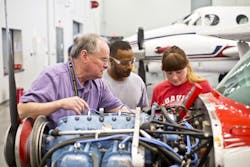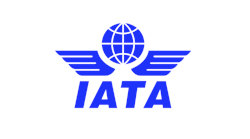Near the airport, in Anthony, KS, sit the remains of a concrete arrow and a beacon tower. They remind us of what was once a network of ‘Beacon-Towers’ stretching from New York to San Francisco. It was the ‘next generation’ of aviation navigation. Before then, pilots navigated primarily by pilotage: looking out their windows for familiar landmarks.
Nearly 1,500 installations in total, the Beacon Tower system was launched in 1924 by the U.S. Postal Service. It was unlike any system anywhere in the world. The network was a big deal. It helped pilots find what they were looking for more quickly and reliably and, more importantly, at night. Innovations in navigation have undoubtedly driven industry growth. Early methods – pilotage, non-directional radio beacons – have given way to today’s satellite-based global positioning systems (GPS).
GPS raised the bar for the entire industry. Safety and service efficiencies are insured with reliable information. Navigation became more precise, enabling closer spacing of planes. Expanded route capacities created value and industry growth.
Navigating Aviation’s Talent Markets: New Opportunities for Growth
Today, aviation industry growth depends on other factors. Talent management – the business of finding, recruiting, and developing a reliable workforce - is now foundational to sustaining industry growth. Compared with innovations in aviation navigation, though, many industry talent management practices still appear to be at the ‘pilotage’ stage of their evolution.
Demand planning methods vary greatly. The use of predictive analytics to understand which job will succeed and why is uneven. Design and administration of skills assessments of incoming talent are often imprecise and uneven. As a result, to borrow a factory floor metric, costs of ‘talent rework’ can be high.
“According to the U.S. Department of Labor, it costs one-third of a new hire’s annual salary to replace him or her.” – Workforce Institute
Step One in managing talent – finding it – can often be a time-consuming ‘seat-of-the-pants’ navigation by employers sifting through innumerable talent markets across the country. Industry leaders are worried.
- “The key to any successful company is its workforce. The aviation sector is no different. Increasingly, however, our member companies find it harder to attract and retain the talent pool necessary to maintain and grow aerospace leadership. To maintain competitiveness, we need a workforce that is ready and available in areas where our manufacturers are located.” – Peter Bunce, CEO, General Aviation Manufacturers Association.
- “Even when the biggest companies and OEMs manage to bring talent into their own organisation, they worry about the talent their subcontractors and suppliers can source. A shortage of talent can make these companies weak links in the production chain when major OEMs increase their output.” – Industry Analysts, Alix Partners, LLP
- “Eighty-six percent of Aeronautical Repair Station Association members reported having difficulty searching for qualified workers, and 26 percent said the search was “very difficult.” – Aviation Institute of Maintenance
Among the many motivations to upgrade the industry’s approaches to talent management is the projected growth in new hires. It’s literally a worldwide challenge.
Navigating the Talent Market: An Aviation Industry Talent Supply Chain
In the face of these challenges, organizations are leaning in to help. One, the National Center for Aviation Training (NCAT) in Wichita, KS, is testing a plan intended to help employers source reliable talent efficiently. Managed by the Wichita Area Technical College (WATC), the center is also home to the National Institute for Aviation Research (NIAR).
The goal is to create an aviation industry talent supply chain organization based at NCAT. The plan’s origins began with research into the demand for talent support services. Intriguing questions emerged. Could NCAT serve regional and national needs? Could educational institutions and certification providers actually work as a supply chain to provide value-added programs and services to employers? How could supply chain management practices help solve talent shortages?
For answers, NCAT executives surveyed industry leaders in late 2015 and early 2016 to discuss their talent management priorities. Topping the list was a frequently voiced concern that employers have limited resources to navigate the educational system. Many expressed concern over an inability to confirm if what is taught is what they need their job candidates to learn in order to perform well.
Almost all the respondents called for better ways to source talent from colleges and universities from multiple markets. Armed with this insight, NCAT’s talent supply chain plan rests on four goals:
- Establish NCAT as a third-party talent provider organization which links the best aviation education and certification programs nationally into a talent supply chain.
- Create teams of institutions to train and deliver job-ready candidates to employers, based on competency specifications set by the employers.
- Provide contracted advisory services to employers on talent management methods and tools.
- Sustain the new enterprise with membership and sponsorship investment options and support for regular trust-based forums to exchange best practices in talent management.
Creating a supply chain of educational institutions poses specific, but surmountable, challenges for educators – the primary ‘suppliers’ of talent. James Hall, WATC’s Dean of Aviation Technologies, leads WATC’s solution design work for its talent supply chain projects with employers. He observed that colleges can be successful talent providers if they work “to help bring colleges and businesses together to provide the exact training required by employers.”
“Many educational institutions out there really don’t have a good connection to the industry and what (the aviation industry) needs from their students,” Daniel Wolfe, National Business Aviation Association, Corporate Aviation Management Committee Member, 2016
An increasing number of colleges and universities think it’s worth the effort. Joining a talent supply chain can redefine the meaning of ‘community’ for community colleges in ways very beneficial to students. Dr. Ian Roark, Vice President for Workforce Development at Pima Community College (and one of NCAT’s talent supply chain members), agrees. “We’re fully on board with the national talent sourcing model NCAT is developing,” he noted. “While most of our students are employed locally or regionally upon program completion, we’ll always have a percentage of our student body interested in pursuing careers outside our immediate community. Participating in the NCAT talent supply chain helps us offer these opportunities as well as expand the talent pool for our own employment base.”
NCAT is researching similar initiatives to help shape its plan. Germany, long-known for assuring industry pools of future talent by mandating apprenticeships, is now home to the new Hamburg Centre of Aviation Training (HCAT). What’s notable about HCAT is how well educators and employers collaborate to develop curricula. Training is truly job-relevant. Expanded capacity created by efficient talent supply chains drives growth and value by supplying reliable talent to employers.
In January 2016 WATC began market testing of its talent supply chain. Input was invited (and continues now) from a cross-section of leaders from individual employers, national industry associations, certification providers, and community and technical colleges.
Responses have been overwhelmingly favorable.
- Employers are notably enthusiastic about a third-party talent provider that could help source talent from educational institutions.
- Educational institutions see opportunities to expand their aviation programs, offer more career pathways for students, and gain access to more industry demand for their capabilities.
- National industry associations express interest in partnering with the new talent supply chain to help them expand their services to their members.
- All respondents agree they would benefit with access to a national source of best practices as they work to improve their organization’s talent fulfillment capabilities.
NCAT and its supply chain members believe that this innovative approach to talent management for employers will help to sustain America’s competitive advantage in aviation. Inquiries are welcomed and additional information about the NCAT Talent Supply Chain may be found at www.watc.edu/ncat.
Tim Welsh, Executive Director – Aviation Industry Services, Wichita Area Technical College. Dr. Welsh has contributed to numerous national workforce development initiatives including with US News and World Report, the U.S. Chamber of Commerce Foundation, and the Aspen Institute. He served as a Trustee for the Manufacturing Institute at the National Association of Manufacturers, and co-chaired the first National STEM Innovation Task Force. Recently, his development of innovative partnerships with educational institutions and industry was featured in Inside Higher Education. Contributors: James Hall, Dean of Aviation Technologies, Wichita Area Technical College, and Dr. Ian Roark, Vice President – Workforce Development, Pima Community College.





